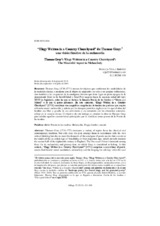Mostrar el registro sencillo del ítem
“Elegy Written in a Country Churchyard” de Thomas Gray: una visión fúnebre de la melancolía
| dc.contributor.author | Villa Jiménez, Rosalía | |
| dc.date.accessioned | 2016-11-18T10:34:20Z | |
| dc.date.available | 2016-11-18T10:34:20Z | |
| dc.date.issued | 2013 | |
| dc.identifier.issn | 2386-9658 | |
| dc.identifier.uri | http://hdl.handle.net/10396/14039 | |
| dc.description.abstract | Thomas Gray (1716-1771) atesora los tópicos que conforman las modalidades de la tradición clásica y moderna con el objeto de adaptarlos no sólo a sus propias reflexiones, sino también a las exigencias de la amalgama literaria que tiene lugar en pleno apogeo de la denominada Edad de la Sensibilidad o Edad Post-augusta hacia la segunda mitad del siglo XVIII en Inglaterra, entre las que se destaca la llamada Poesía de las tumbas o “Graveyard School” a la que el poeta pertenece. En este contexto, “Elegy Written in a Country Churchyard” (1751) constituye una magnifica compilación de tendencias poéticas que respira reflexión moral, melancolía y anhelo por los tiempos pretéritos ingleses en los que el alma del hombre era libre y gozaba de sus actividades y su comunión con los elementos naturales, reflejo de la esencia divina. El objetivo de este trabajo es estudiar la obra de Thomas Gray para señalar aquellas características principales que la clasifican como poema de la Poesía de las tumbas. | es_ES |
| dc.description.abstract | Thomas Gray (1716-1771) treasures a variety of topics from the classical and contemporary tradition. Not only does the poet arrange them in accordance with his own critical thinking but also to meet the demands of the amalgam of poetic modes that coexist at the zenith of the so-called Age of Sensibility or Post-Augustan Age, which prevails towards the second half of the eighteenth-century in England. The Graveyard School outstands among these for its melancholy and gloomy tone, to which Gray is considered to belong. In this context, “Elegy Written in a Country Churchyard” (1751) comprises a miscellany of poetic modes that breathe moral meditation, melancholy and the longing for old days when the soul of man was free and man enjoyed himself in his rural activities in perfect harmony with God and Nature. The main goal of this paper is to study Thomas Gray’s “Elegy Written in a Country Churchyard” to highlight the mainstream features that place it within the “Graveyard School”. | es_ES |
| dc.format.mimetype | application/pdf | es_ES |
| dc.language.iso | spa | es_ES |
| dc.publisher | UCOPress | es_ES |
| dc.rights | https://creativecommons.org/licenses/by/3.0/ | es_ES |
| dc.source | Alfinge 25, 131-150 (2013) | es_ES |
| dc.subject | Poesía de las tumbas | es_ES |
| dc.subject | Melancolía | es_ES |
| dc.subject | Elegía fúnebre | es_ES |
| dc.subject | Muerte | es_ES |
| dc.subject | Graveyard School | es_ES |
| dc.subject | Melancholy | es_ES |
| dc.subject | Funerary elegy | es_ES |
| dc.subject | Death | es_ES |
| dc.title | “Elegy Written in a Country Churchyard” de Thomas Gray: una visión fúnebre de la melancolía | es_ES |
| dc.title.alternative | Thomas Gray’s ‘Elegy Written in a Country Churchyard’: The Mournful Aspect in Melancholy | es_ES |
| dc.type | info:eu-repo/semantics/article | es_ES |
| dc.relation.publisherversion | https://www.uco.es/ucopress/ojs/index.php/alfinge/index | es_ES |
| dc.rights.accessRights | info:eu-repo/semantics/openAccess | es_ES |

